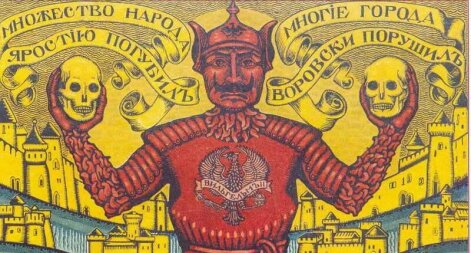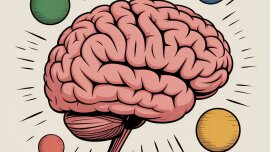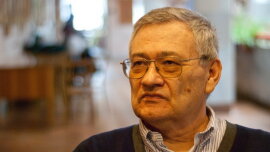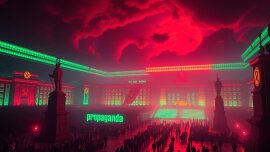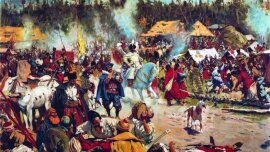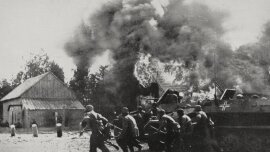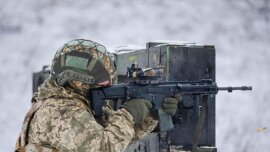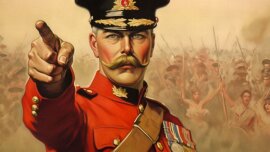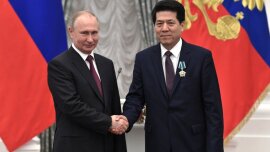"He answered them, "He who sows the good seed is the Son of Man; the field is peace; the good seed are the sons of the kingdom, and the tares are the sons of the evil one; the enemy who sowed them is the devil; the harvest is the end of the age, and the reapers are angels." Matthew 13:37-39
In the rattling of 1914, the famous artist Nikolai Roerich created a lubok poster "The Enemy of the Human Family". It depicted the instigator of the Great War William II in the image of Satan, who, as the poster inscriptions said, "furiously destroyed many people" and "thieves destroyed many cities." This image of the Kaiser was not just an expression of the author's patriotic feeling, but was largely the result of Roerich's deep spiritual confusion. The painter was horrified by the mass shootings of civilians and bombing of architectural monuments committed by the Germans in Belgium and France.
The enemy of the human race. Poster 1914
Looking at this poster these days, we can involuntarily notice how another force prophetically appeared through the image of William, described by Roerich in 1919 as "vulgar and hypocritical", "complete betrayal and bribery", based on the "distortion of all the holy foundations of mankind" - Bolshevism. Indeed, the face of the mustached Satan-Kaiser, dressed in red armor and pickelhelm with a five times cut Prussian eagle, is mysteriously transformed into the guise of the symbol of the Civil War, the "red Murat" of Semyon Budyonny, put in a helmet of the same name with a five-pointed red star. In addition to the German armies in Belgium and France, his 1st cavalry carried destruction and deprivation to the residents of the Don, Kuban, Ukraine, and Poland.
The connection of German militarism with Bolshevism cannot be limited to Roerich's artistic and historical intuition, since these two ideologies were the concentration of the world evil of the twentieth century, which sought to spiritually and physically subdue all mankind. This destructive intention found its utmost expression in the Wilhelm-Hitler thirst for world domination, as well as Bolshevik zeal for the implementation of the world revolution.
At the same time, at this historical moment, we are witnessing how Putin's Russia became the successor to the German-Bolshevik hordes of the last century, starting to sow the chaffs of death and destruction on the land of Ukraine. That is why the current war of the Ukrainian people with the Russian horde, which voluntarily decided to become an opponent of the kingdom of the enemy of the human race, is a continuation of the war with the world evil of the twentieth century - a war on the bones of the victims of which a peaceful and prosperous Europe was born.
The legitimacy of the above thesis is revealed when considering the very nature of the actions of Russian troops in Ukraine and comparing it with the essence of the actions of the German-Bolshevik forces in the wars of the last century.
I
The first most terrible manifestation of Russia's connection with the evil of the twentieth century can be called the use of terror against the peaceful Ukrainian population, and it absorbed both the German and Bolshevik experience of organizing intimidation.
German continuity is characterized by the elevation of the very method of terror to the degree of Lucifer's "logical self-legitimate necessity". We find the prototype of this construction already in the theoretical constructions of Karl von Clausewitz, who noted that "to fulfill our will, we must put the enemy in a heavier position than the sacrifice we demand from him."[1] In 1914, the German military, grown on such concepts, obsessed with, in addition, a manic fear of frontier guerrillas, launched a full-scale terror against the population of Belgium and France, deliberately killing 6,427 civilians [2].
Thus, on August 4-5, 1914, the Germans leveled the town of Erv - only 19 of the 500 houses survived, while the streets of the settlement, according to eyewitnesses, were covered by the murdered residents [3]. Two weeks later, on August 20, 110 residents of the village of Andenn were executed by the Germans [4], and on August 22, the occupiers, in retaliation for the stubborn resistance of French troops, drove 384 people to the square of the mining city of Taemin, lined them up and shot them with rifles and machine guns. The youngest of the victims of this terrible day was 13 years old, the eldest was 84 years old [5]. The next day, the Germans committed an even larger atrocity in the city of Dinan: 612 people, including a small child, were shot as a reckoning for the alleged shelling of German soldiers [6]. On August 25, a German airship carried out an airstrike on Antwerp, killing 10 urban residents and wounding 2 others [7]. The climax of German "logical Luciferianism" was the destruction of Leuven - on August 25, the German command, also as revenge for the ghostly attacks on its soldiers and officers, ordered the burning of this great medieval city and the beginning of repression against civilians [8].
"We will level the city with the ground, we will not leave a stone on the stone! Not a single stone, I tell you! We will teach them to respect Germany! People will come here for centuries to see what we've done!"[9], - this is how one German officer described the Leuven tragedy and it seems that a similar demon-possessed howl has repeatedly sounded from the mouth of the Russian military and politicians concerning the cities of Ukraine.
Indeed, failing to implement the notorious Blitzkrieg and faced with widespread popular resistance, the Russian command, faithful to the above Clausewitz principle, switched to using a strategy of intimidation. This latter, aimed at moral suppression of the Ukrainian population, is implemented through shootings, organizing air raids, carrying out artillery and missile strikes, as well as blocking humanitarian corridors. It is impossible to describe all the atrocities of the Russian army in Ukraine within the framework of this essay, but it is possible to highlight such episodes of the Ukrainian-Russian war, which clearly showed how closely Putin's Russia is connected with the dark German spirit of the last century.
The blockade of Mariupol, which began on March 1 of this year, demonstrates this continuity with frightening clarity: the Russians, following the inglorious German paths, have brought the city to a state of complete destruction and continue their massacres of civilians. The symbols of Russian military atrocities were the bombing of the maternity hospital and children's hospital on March 9, as well as the raid on March 16 on the premises of the Neptune swimming pool and the Mariupol Drama Theater. Particularly striking is the comment of Russian Foreign Minister Sergei Lavrov regarding the first event: he generally denied the presence of women in labor and medical personnel in these buildings, "legitimizing" the bombing with the "old presence" in the buildings of soldiers of the Azov regiment. The criminal cynicism of this statement is obvious - the words of the Russian minister are full of the very fearful lies with which the Germans justified their barbarism in Belgium and France. The only difference is that the place of the Frantirers was taken by Azov. At the time of writing these lines, according to preliminary estimates alone, the number of victims of Russian terror in Mariupol reached 5,000 people, including women in labor and children. More than 170,000 of our citizens are still under siege.
Another example of intimidation strikes is the attacks on Kharkiv. Since the beginning of the war, the city has been subjected to unprecedented destruction. By March 31, almost 1,300 residential buildings had been destroyed, architectural monuments were damaged - Holy Dormition Cathedral (1657), St. Anthony's Church (1831), Palace of Labor (1916), the building of the Kharkiv Court of Appeal (1902), the building of the Kharkiv Library named after Korolenko (1901), the building of Kharkiv-Passenger railway station (1952), building of Kharkiv University named after Karazin and many other historical buildings. In connection with these atrocities, it is worth recalling the confessions of the captured Russian pilot who carried out 3 air raids on Kharkiv between the end of February and the beginning of March this year. During a press conference, Lieutenant Colonel of the 47th Aviation Regiment said that on March 6 he deliberately went to comply with a criminal order, dropping 4 tons of high-explosive bombs on civilians in residential areas of the city. The question involuntarily arises: did Kharkiv bombard the adept of the "sworn-in", "law-abiding citizen" of the Third Reich, and executive accomplice in the murders of millions of Jews of SS Obersturmbannführer Adolf Eichmann?
Ancient Chernihiv also shudders with the blows of intimidation - a humanitarian catastrophe has occurred in the city. By the end of March, the number of victims of Russian terror had reached 400 people, and daily news of dozens of dead and wounded as a result of shelling makes you shudder. Among the affected architectural monuments are the Yelets Assumption Monastery (XI century), St. Kazan Church (1827), and the house of the famous philanthropist Vasily Tarnovsky (the 1890s). As the mayor of the city, Vladislav Atroshenko stated, the Russian bombing of Chernihiv is comparable to those carried out by German troops in 1943 - "the fire is carried out untargeted and throughout the city."
To complete the comparison of Russian atrocities with German atrocities, it is worth paying attention to another phenomenon. Maraudering is especially common among Russian troops. Testimonies of Ukrainian residents and data from Ukrainian intelligence reveal numerous facts about such war crimes. Hungry, poor, and poor Russians take everything possible out of Ukrainian homes - from ordinary utensils to high-tech equipment. In 1918, a similar looting passion surrounded German soldiers. The poet and novelist Rudolf von Binding left an eloquent description: "Strange figures, little resembling soldiers and, of course, little thought about the offensive, wandered from the city. Who drove the cow... who carried chicken under one mouse and a box of mail paper under the other. People with bottles of wine under their arms and uncorked in their hands... People staggering from side to side... People crawling almost on all fours... When I got into the city, the streets were flooded with wine..." [10].
It remains only to add that the tragic fate of Mariupol, Kharkiv, and Chernihiv is shared by many settlements of Ukraine - the Russian Lumpen County is inexorable in its desire to destroy thousands of innocent Ukrainian lives, plunder Ukrainian cities and villages, as well as destroy Ukrainian culture.
At the same time, Bolshevik roots are also observed in the Russian strategy of intimidation. In particular, we are talking about the use by the occupying forces of the method of individual terror - the continuation of red terror during the Civil War. The essence of the latter, as you know, was to destroy members of those estates and social groups that posed a danger to the existence of the Bolshevik regime [11]. Red terror was thus dogmatic terror aimed at the complete extermination of the spirit of freedom and individuality. At the same time, in full accordance with Clausewitz's views on the ultimate goals of the Red Repression, People's Commissar for Military Affairs of the RSFSR Lev Trotsky spoke in 1919: "terror as a demonstration of the strength and will of the working class will receive its historical justification precisely in the fact that the proletariat managed to break The result of such an inhuman "break of the will" in 1917-1922 was the destruction of at least 1.7-1.8 million people [12].
In Ukraine, the symbols of red terror were the shootings of thousands of officers in Kyiv in January 1918, the mass repression of the summer of 1919, and the Crimean tragedy of 1920-1921.
Now we are witnessing how Russian troops begin to apply Bolshevik practices in the occupied territories of Ukraine. Terror is waged against innocent citizens and individual socio-professional groups that pose a threat to the Russian authorities. In the latter case, we are talking about the heads of united territorial communities and mayors, veterans of the war in Donbas, priests, volunteers, journalists, as well as all those determined citizens ready to resist the occupation. The rock of history is monastic - in 1917-1922 the punishing sword of Bolshevism hung over representatives of similar social groups: "the vast majority of those arrested - as can be seen from the report of the Russian Red Cross of February 14, 1920 - were guilty simply of being educated people or belonging to the bourgeoisie (...) officer, landowner, priest, engineer, lawyer, teacher were always under suspicion. [13]"
A well-known phenomenon of the current war is the abduction and destruction of representatives of local self-government by Russian troops. A similar fate, for example, befell the mayor of Melitopol Ivan Fedorov (now, fortunately, released), the mayor of Skadovsk Alexander Yakovlev, and his deputy Yuri Palyukh, deputy mayor of Energodar Ivan Samoydyuk, as well as the head of the Velikoburluk community Viktor Tereshchenko. Particularly noteworthy is the story of Dmitry Vasilyev, the secretary of the Novaya Kakhovka City Council, kidnapped by the Russian invaders - according to his wife, the occupiers began to torture him because he refused to cooperate with them. Truly terrible, but as President of Ukraine Volodymyr Zelenskyy stated on March 28, some of the mayors of cities kidnapped by the occupiers were victims of Russian terror. In connection with these tragic incidents, it is impossible not to recall the fate of the prominent figure of the self-government of Kherson province Yakov Erdeli, who was arrested three times by the Bolsheviks, and for the fourth time, apparently in the summer of 1919, was subjected to the most painful torture and killed [14]. During the same period of the Kharkiv Cheka, the former Izyum district leader of the nobility, former Kherson and Irkutsk governor Fyodor Bantysh, and his son Antiochus, was shot [15]. It is also known that in May 1919, Kyiv Governor Nikolai Sukovkin was shot [16].
Similarly, Russian troops carry out terror against scientists and educators in Ukraine. It is known that during the atrocities in the suburbs of Kyiv, the occupiers shot Professor, Doctor of Physical and Mathematical Sciences Vasily Kladko (the tragedy occurred on March 13 in Vorzel), as well as Professor, Doctor of Pedagogical Sciences Yevgeny Khrikov (died at the hands of the occupiers on March 23). According to the testimony of representatives of the educational community of Ukraine in Bucha, Russians carried out shootings of school teachers and kindergarten teachers. The same atrocities occurred in Kyiv in the summer of 1919, when the Bolsheviks shot 36 professors [17].
Separately, let's focus on the facts of the persecution of Ukrainian volunteers and veterans of the war in Donbas. On March 15, the head of the Mykolaiv military-civil administration Vitaly Kim said that in the village of Peski (Novodessa district), separatists from the L/DPR shot veterans of the anti-terrorist operation, as well as made pogroms and robberies of the local population. Moreover, according to the reports of the General Staff of Ukraine on March 26, in the Kherson region, the Russian occupation troops began work to identify local residents - as participants in the anti-terrorist operation and the operation of the joint forces. In their persecution of Ukrainian veterans, the Russian military repeats the Chekist experience of terrorizing officers. In the light of these comparisons, the death of the famous volunteer Alexander Kononov makes a special impression - the Russian occupiers shot him in a wheelchair right in their own house located near Severodonetsk. The Bolsheviks committed a comparable act of terror during the occupation of Mariupol, in early March 1919: breaking into the Zemstvo hospital, the Red Army shot 4 typhus officers and volunteer soldiers [18]. Formed ruthlessness makes modern Russian soldiers direct followers of demon-possessed representatives of the Red Horde.
Another fact related to the history of Mariupol also deserves attention: in April 1919, on the eve of the offensive of the AFSR troops, the Bolsheviks began the forced evacuation of the male population of the city. Disobedience was punished by shooting. In total, up to 10,000 people aged 18 to 40 years were stolen [19]. And as if by the intuition of the spirit of evil, during the real war, Russian troops also began to forcibly steal residents of besieged Mariupol to Russia. The disasters of our compatriots have no end: from their native destroyed city, after the so-called "filtration", they are taken straight to Russia. The number of forcibly deported Mariupol residents has already exceeded the figures of 1919 and reached 30,000 people.
The following events also prove the authenticity of Bolshevik continuity. According to the head of the Sumy Military Administration Dmitry Zhivitsky, during the occupation of Trostyanets, Russian troops reached the point that they did not allow to bury dead and dead people. During the Civil War, there were many cases when security officers and Red Army soldiers also deliberately forbade betraying the people they tortured to the ground. Let's give the following example: from March 20 to 25, 1919, the Bolsheviks caused pogroms in occupied Yuzovka - shops were plundered, apartments were looted, mass shootings were organized. In those days of red robbery, the newly formed revolutionary committee forbade the burial of the bodies of the murdered residents of the city [20].
Other cases occurred in Trostyanets, also referring to the history of the Red Terror. On March 28, the news was received that after the liberation of the city, Ukrainian soldiers found the corpses of people with much bodily harm, indicating torture by the occupiers. A resident of the neighboring village of Bromlya was also tortured - Russian soldiers beat him for an hour, and completely mutilated his head, broke his jaw and finger [21]. The manifestation of such atrocities against civilians has been recorded in other occupied parts of Ukraine. Mass violence took place in the Kyiv region, in particular in Irpin, Bucha, Gostomel, and Vorzel. The most cruelty in them was shown by Kadyrov units. In the Kherson region, there is an incident when the occupiers took 12 local activists from Energodar to the forest, after which they tortured and bullied them. In the Kharkiv region, there is literally a revival of the Cheka - eloquent descriptions of the atrocities of the occupiers in the town of Cossack Lopan were given by resident Alexei Semikov, whom Russian soldiers tortured most painfully.
In an interview with Hromadsky, he described the experience of being in the Russian dungeon as follows: "The basement was filled with people. A farmer man was placed next to me. I identified him, he has his own stable, a big house in a neighboring village. He asked, "What did you take us for? We just stayed at home with our family and had lunch." He was beaten and answered and shouted: "Where did you get the money for such a house? Do you have money?" He promised to give all the money, as long as it wouldn't beat his son because he has leukemia. At that very moment, they started beating their son. Soon we were all taken outside. It was necessary to kneel in the snow and rest my head against the wall. We were called to talk in turn. I stood like this for three hours, maybe more. I've even fallen asleep. I got frostbite on my legs. The sounds of beatings and moans of people were heard from the basement. That's how it was with everyone..." [22].
This description seems to repeat episodes of the red terror in Kharkiv in 1919: "The arrested person was removed from the cell at 2-3 a.m. and taken somewhere. The rest heard the cries of tortured, muffled by the noises of drunks and the singing of cheerful employees of communist dungeons. Often interrogated people were taken back with towel-tied heads, bloody backs, and other marks of the communist court. The most common torture consisted of boiling parts of the body with boiling water, injections under the nails, and beating with iron rods" [23]. Similar superstitions were made by security officers in every city where Soviet power was established.
It is also striking how Russian troops shoot civilians. In early April, after the liberation of the Kyiv region by the Ukrainian army and the discovery of victims of Russian terror (Bucha, Motyzhin), it was established that the occupiers killed civilians with a shot in the back of the head. This method of execution was widespread in the dungeons of the Cheka. Let's turn to excerpts from the archives of the Special Commission to Investigate the Atrocities of the Bolsheviks in Kyiv (first half of 1919): "The shooting began at two o'clock in the morning and ended at four in the morning. Naked suicide bombers were taken dozens to the shed of executions. There they were ordered to lie facing the floor. Ten shots at point-blank range in the back of the head - and the skulls of ten victims flew to pieces, blood and brain covered the floor, the walls of the ceiling. (...) The check ordered: the Red Army took out other prisoners, forced them to dig graves, take them out of the barn and throw 123 bodies into the grave, falling asleep somehow” [24].
So what is a Russian army? It is a horde that has absorbed the anti-human experience of the German-Bolshevik evil of the twentieth century. A Russian soldier is an uninitiated executor of criminal orders; he is a beggar rioter who has reached modest Ukrainian prosperity; he is a follower of a fierce security officer who shoots people not only to achieve the Lucifersky pragmatic effect of intimidation but also due to the loss of the ability to determine good and The Russian soldier turned into an instrument of the enemy of the human race.
II
The second representation of Russia's connection with the German-Bolshevik forces of the last century is the spiritual continuity of its ruler Vladimir Putin with the instigators of the world fires of the twentieth century - Wilhelm II, Vladimir Lenin, and Adolf Hitler. The minds of the three spokesmen of the darkness of the last century, as noted in the introduction, were gripped by the idea of establishing comprehensive physical and spiritual control over humanity - an idea that in its practical dimension led the world to destruction and deaths of millions of people. Here it is important to note one, if I may, have a genealogical detail: it was German militarism, firstly, that contributed to the establishment of Bolshevism in Russia, and secondly, in the strongest way influenced the system of views of the future Fuhrer. Therefore, to comprehend Putin as the successor to the world evil of the twentieth century, it is necessary first of all to touch upon the image of Wilhelm.
In 1896, in one of his speeches, the young Kaiser proclaimed the main goal of his activities - to achieve a position in which "the Germans would get their place in the sun” [25]. Wilhelm's unprecedented need to recognize Germany directed his people to a catastrophe that ended only in 1945. The militaristic aspirations of the Kaiser were strengthened every new year of his reign, and concepts such as Weltpolitik and Weltmacht [26] turned into a kind of categorical imperative for German society [27].
In 1897, the Kaiser began a naval rivalry with the British Empire, saying that Poseidon "the three-tooth should be in our hands." A year later, in November 1898, during a speech in Damascus, he declared himself the patron of 300 million Muslims, which, of course, only increased hostility on the part of Russia and Britain. The first result of such insinuations was the Anglo-Japanese (1902) and the Anglo-French rapprochement (1903-1904). Already in 1905, Wilhelm's Tangier antics took place, which almost entered the war with France, as well as an unsuccessful action to conclude the Bierk Agreement with Nicholas II. Soon there was a reaction to the very dubious and aggressive foreign policy of the Kaiser on the part of Russia: in 1907. St. Petersburg feared what was said on the eve of and during the revolution of 1905. Berlin's claims to the Baltic provinces concluded an agreement with London that completed the cause of the "environment" of the German Empire [28]. Subsequently, until 1914, a noticeable improvement in relations between Germany, Great Britain, and France was bizarrely combined with the threateningly increasing militant rhetoric of the Kaiser [29].
Interestingly, on the margins of one dispatch received from the ambassador to London in 1908, Wilhelm drew: "If they want war, let them start, we are not afraid of it!" [30]; in 1910, during a speech, even more, alarming words were heard before naval officers and cadets from the mouth the Kaiser: "The next war and the next naval battle will require healthy nerves from you”[31]. But the most terrible thoughts, as if foreshadowing the onset of Nazism, were expressed in 1912: "A possible battle for existence that the Germans (Austria, Germany) will have to wage in Europe against the Slavs supported by the Romanesque peoples (Galla) (Russia), the Anglo-Saxons will be on the side of the Slavs... Reason: envy, fear of our movement towards greatness!" But not only that: "There is a fight of the Germans against the Russo-Galls for the very existence. And no conference can settle it, as it's not a matter of big politics, but a problem of the race... And now it's about whether or not to be a German race in Europe” [32].
As you can see, Hitler, with whom Putin rightly began to associate, was not original in his destructive racial and great German views, but only brought to the extreme destructive scale the ideas that gripped Wilhelm and the German elite at the beginning of the twentieth century.
The militarist megalomania of the Kaiser type is exactly what Russia has plunged into over the past 20 years. Like Wilhelm, Putin from the very beginning of his reign took a course to restore Russia's former greatness, dragging into the abyss not only the Russians gradually engulfed by him, but also, above all, other peoples who had yet to survive the scourge of the foreign policy ambitions of the ruler of Russia.
In the article "Russia at the turn of the millennium", symbolically published on December 30, 1999, Putin gave the following description of his state: "Russia has been and will remain a great country. This is due to the inherent characteristics of its geopolitical, economic, and cultural existence. They determined the mood of Russians and state policy throughout the history of Russia (...) The situation is really difficult. However, it is premature to sing Russia as a great power, to put it mildly." Such a gloomy tone of the article, however, 4 years later changed to more decisive rhetoric. In 2004, during his inaugural speech, Putin prophetically stated: "Our past certainly gives us strength. But even the most glorious story itself will not provide us with a better life. This greatness must be reinforced. Reinforced by new affairs of today's generations of citizens of our country."
And he was true to his words: the path to Russia's greatness lay through the war in Georgia in 2008, the annexation of Crimea and the war in Donbas in 2014, as well as the entry into the Syrian Civil War in 2015. Now, this very path is shamefully ending in Ukraine.
In addition to the megalomania, Putin has a relapse of Wilhelm's paranoid "environment" - we are talking about his fear of eastern NATO expansion. In 2015, the President of the Russian Federation was aware of "foreign NATO legions" that acted under the banner of Ukraine, and a year later he warned the Finnish government against joining the North Atlantic Alliance, and in a distinctively aggressive form: "(...) NATO would probably gladly fight Russia until the last Finnish soldier, do you need it?" A year later, Putin was again gripped by psychosis regarding Ukraine's integration into NATO and the placement of "some (sic!) Radars and missile defense systems." In 2019, he threatened the Alliance countries with the possibility of using special weapons systems "not only concerning those territories from which we will pose an appropriate direct threat but also against those territories where decision-making centers on the use of missile systems threatening us are located." As a result, at the end of 2021. Russia announced a NATO ultimatum containing demands to exclude further expansion, abandon any military activity in Eastern Europe, Transcaucasia, and Central Asia, as well as to consolidate the principle of Ukraine's non-alignment to the Alliance.
Like Wilhelm, Putin, with his aggressive policy, created all the necessary conditions to strengthen the natural desire of individual neighboring states to find protection mechanisms against the militant Kremlin. Soaked with escapism, the Russian murmuring around the so-called "eastern expansion of NATO" actually expresses the expansive foundations of Putin's state, which seeks to find any possible justification for its militaristic aspirations. In this sense, it seems possible to conclude that in Putin's mind the current war with Ukraine is the same as in Wilhelm's mind there was a "bate for the existence of Germany".
The figure of Hitler also allows us to comprehend Putin's connection with the darkness of the twentieth century. The above pointed out the unoriginality of the foundations of the bloody Fuhrer concepts, so there is no need to detect them in Putin's views and deeds. Another thing is important: the President of Russia adopted the skill of a “spirebrecher” from Hitler. The latter, according to Dutch culturologist Johan Heisinga, is a subject that completely breaks the world of the community, which is included in a particular game [33]. The scientist wrote: "By refusing to play, he exposes the relativity and fragility of the world of the game in which he was temporary with others” [34]. If we take into account the game element of international relations, it can be stated that Hitler, following his "super-value idea" of the revival of Greater Germany, with passion broke the image of the world created by the Treaty of Versailles of 1919. Putin, in turn, being in the power of the idea of reviving Russia, breaks the current image of the Eastern European world. In these two well-known comparisons to Ukrainians, one thing is ghostly pleasing: as Heising believed, the “spirebrecher” should be destroyed or at least sent into exile - I want to believe that this is what we see today with Russia.
Finally, the last key to understanding Putin as a henchman of the evil of the twentieth century is Lenin's personality. Being initially an instrument of German militarists in their plans to revolutionize Russia, the leader of the Bolsheviks developed himself and his red horde to the scale of force that determines the course of world history. The foundations of Bolshevism were masterfully revealed by Nikolai Berdyaev back in 1917: "This air hates being as a quality, as an exaltation, and in the name of equality and blissful comfort destroys it and plunges it into oblivion” [35]. Lenin hated the spirit of freedom, hated any manifestation of culture, and in his hatred he reached the total extermination of all those who sought to preserve the principle of human dignity. We find confirmation of this in the truly terrible thoughts expressed by the Grand Red Inquisitor in November 1918: "It would be ridiculous and ridiculous to give up terror and suppression against landlords and capitalists with their henchmen selling Russia to foreign "union" imperialists” [36]. This Lenin's infernal laughter was heard from the mouth of the executioners of the Cheka, who found true pleasure in torture and executions, which not only calmed the bloodthirsty spirit of their leader, hungry for the blood of the "enemies of the proletariat", but also brought closer the offensive on earth of the kingdom of the antichrist, the kingdom of nothingness. It was he who brought to mankind the world revolution, the idea of which Lenin lived.
For his own part, Putin, as a personnel security officer, inherited from the Bolshevik leader the rejection of the spirit of freedom. Especially, this is expressed in the denial by the ruler of Russia of the natural right of people to strive for spiritual ideals, which are different from the modern, deeply perverted Russian worldview. Moreover, Putin finds the "blessed calm" mentioned by Berdyaev just in the bloodthirsty suppression of such aspiration. In this sense, when the ruler of Russia announced in June 2021 that Ukrainians and Russians were "one people", he thereby denied us the right to individuality and identity; he denied us the right to self-sufficiency; he denied us the right to exist. The logically following such declarations, the destruction of Ukraine and the destruction of its population is the result of Putin's denial of freedom, Putin's inquisition.
Who is Putin in the end? Before us is a militant megalomaniac that combines the features of Wilhelm-Hitler and Leninist militarism. The ruler of Russia lives with the idea of restoring the former greatness of his country, and he embodies this idea with traditional tools for the twentieth-century - foreign policy “spirebrecherism”, active military expansion, as well as ruthless terror. In other words, Putin is completely at the mercy of the military system of the XX century, which now determines the nature of the Ukrainian-Russian war. The President of Russia is a perverted child of the world evil of the last century, who decided to impose his spiritual and intellectual regression on the world of the XXI century.
III
Having considered Russian acts in a comparative historical light, we can answer the final question of this essay: what are the spiritual foundations of the Ukrainian-Russian war?
The entire "special operation" of the Kremlin degenerated into the pogrom of Ukraine, exposing the real essence of the modern Russian idea. Putin's attempts to find this last one in the ghostly splendor of Russian history ended with the appearance of a terrible chimera, which perversely synthesized the incongruous heritage of the imperial and Soviet periods. There was no deep spiritual and intellectual appeal in Putin's ideological and historical search, so, as a result, there was no repentance for the evil brought to the world of the twentieth century by Russia. Instead of a humble confession of sin, Putin accepted the temptation of pride, using the history of his country in the name of his own vanity-impregnated goals; instead of finding the spirit of Russia, he found the spirit of evil, which, having covered the whole of Russia, now again declares itself to humanity. This spirit, as Berdyaev accurately described it, asserts the low origin of man, postulating the principle of "people are not sons of God, but sons of peace” [37].
The philosopher's thought, expressed in fateful 1917, hides the true essence of the modern Russian idea - the phenomenon of a relic passing through the entire past century. This is the idea of the German tornado led through the lands of France and Belgium, it was it that reigned in the dungeons of the Cheka and Nazi death camps. Now the bearers of this idea, denying both themselves and other peoples the right to have human dignity, fiercely destroy the Ukrainian population, as well as thieves, destroy the cities and villages of Ukraine - through a century we again witness the coming of the enemy of the human race, as Roerich depicted it in 1914. The only difference is that the face of the German Kaiser has changed to the face of the current ruler of Russia, who embodied the dreams of the main demon of Russian literature Peter Verkhovensky: "We will make such confusion that everything will go from the basics! (...) We will stink the desire: we will let drunkenness, gossip, denunciation; we will let unheard of debauchery; we will extinguish every genius in infancy (...) Slaves must have rulers. Complete obedience, complete impersonality (...) But one or two generations of debauchery is necessary; debauchery unheard of, means when a person turns into ugly, cowardly, cruel, self-loving scum - that's what you need! We will proclaim destruction (...) We will let fire... We will let the legends (...) Well, the turmoil will begin! The singing will go like the world hasn't seen yet! Russia will be blurred, cry for the old gods...” [38].
But what confronts the spirit of evil? This is the very force that stopped German militarism in 1914, showing the world a miracle on the Marne. In 1920, she stopped Bolshevism, showing the world a miracle on the Vistula, and in 1942 she was destined to reverse the course of world history, striking a crushing blow to Hitler's coalition in different parts of the Earth. Today, in 2022, this force stops Putin's Russia, showing the world of the XXI century a miracle over the Dnieper. The essence of this force was revealed by Marshal Ferdinand Foch. In particular, answering the question of why he launched an offensive on the Marne when he was technically defeated, he honestly replied: "Why? I don't know. Because I believed in my people because I had the will. And then... God was with us” [39]. Deep faith in a person, affirmation of his dignity, and loyalty to the ideals of freedom - all these values are defended by the Ukrainian people in the war with the Russian kingdom of evil.
There is no and will be no spirit of victory behind Russia - behind it only a host of "infinite, ugly" demons of the twentieth century, shadows of executioners of the past era. On the contrary, behind Ukraine is the eternal light of the past victories of mankind. In the sorrows of the current war, we gain spiritual unity with the tragedies of the twentieth century, we gain an understanding of the victims of that time and with our struggle, we honor the memory of those who fell in confrontation with the world evil of the last century. All this is the path of victory; all this will be the grains of Good, which we will sow in the new Ukraine, in the world of the XXI century.
1 Clausewitz K. About the war. M.: Logos; Nauka, 1994, p. 38.
2 Takman B. August guns. M.: AST, 2014. S.401-402.
3 Gilbert M. The First World War. M.: Hummingbird, Azbuka-Atticus, 2016. S. 68.
4 Ibid. pp. 75-76.
5 Ibid. S. 76.
6 Tuckman B. Decree. Op. S. 405.
7 Gilbert. Decree. Op. S. 76.
8 Ibid. S. 77.
9 Tuckman B. Decree. Op. S. 410.
10 Liddell Hart B. History of the First World War. Moscow: AST, 2014, pp. 472–473.
11 Red terror through the eyes of eyewitnesses. M.: Iris-press, 2013. S. 7.
12 Red terror through the eyes of eyewitnesses. S. 8.
13 Ibid. S. 37.
14 Felshtinsky Yu. Red terror during the Civil War: based on the materials of the Special Investigation Commission to investigate the atrocities of the Bolsheviks. M .: Terra-book club, 2004. S. 270.
15 Ibid. S. 254.
16 Ibid. S. 267.
17 Red terror through the eyes of eyewitnesses. S. 80.
18 Felshtinsky Yu. Decree. Op. S. 226.
19 Ibid. S. 227.
20 Ibid. S. 222.
21 “We tried to cut a finger, then we did it” - about the signing of the Russian military in the Sumy region // Suspіlne. 03/21/2022
22 Three days of captivity, severe beatings and flight through the fields // Hromadske. 03/29/2022.
23 Red Terror in the South of Russia. M.: Iris-press, 2013. S. 267.
24 Ibid. pp. 234–235.
25 Fisher F. Rush to world domination. The military objectives policy of Kaiser Germany in 1914–1918. M.: Political Encyclopedia, 2017. S. 27–28.
26 "World politics" and "world domination".
27 Radkau J. The era of nervousness. Germany from Bismarck to Hitler. M.: Ed. House of the Higher School of Economics, 2017. P. 281.
28 Fisher. Decree. Op. pp. 39–40.
29 Liddell Garth. Decree. Op. S. 27.
30 Hastings M. The First World War: The Catastrophe of 1914. M.: Alpina-non-fiction, 2014. S. 34.
31 Radkau J. Decree. Op. S. 401.
32 Fisher. Decree. Op. S. 50.
33 Huizinga J. Homo ludens. The person playing. St. Petersburg: Ivan Limbakh Publishing House, 2017. P. 36 - 37.
34 Ibid.
35 Berdyaev N. Spiritual Foundations of the Russian Revolution: Experiences of 1917–1918. St. Petersburg: RKHGI, 1998. S. 47–48.
36 Lenin V. Complete Works. T. 37. July 1918 - March 1919. M .: Politizdat, 1969. S. 194.
37 Berdyaev. Decree. Op. pp. 47–48.
38 Dostoevsky F. Demons. St. Petersburg: Printing house of the Panteleev brothers, 1890, pp. 385–389.
39 Tuckman B. Decree. Op. S. 54.
